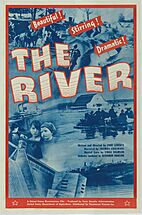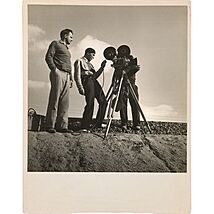Pare Lorentz facts for kids
Quick facts for kids
Pare Lorentz
|
|
|---|---|

Pare Lorentz, 1935—1942
|
|
| Born |
Leonard MacTaggart Lorentz
December 11, 1905 Clarksburg, West Virginia, United States
|
| Died | March 4, 1992 (aged 86) Armonk, New York
|
| Alma mater |
|
| Occupation | Filmmaker and critic |
| Employer | Resettlement Administration |
| Organization | WWII U.S. Army Air Corps, Colonel |
| Known for |
|
| Movement | New Deal |
| Spouse(s) |
|
| Children |
|
| Parent(s) |
|
| Awards |
|
Pare Lorentz (born December 11, 1905 – died March 4, 1992) was an American filmmaker. He was famous for making movies about the New Deal, a series of programs in the United States during the Great Depression. His birth name was Leonard MacTaggart Lorentz. He was born in Clarksburg, West Virginia. He went to West Virginia Wesleyan College and West Virginia University.
Lorentz started as a film critic in New York City and Hollywood. He often spoke out against film censorship. During the Great Depression, he became a very important documentary filmmaker. He believed the government should support films that showed important issues. Later, during World War II, he made many films for the U.S. Army Air Corps. This included technical films and even a movie about the Nuremberg trials to show the world what the Nazis had done. Many people remember him as "FDR's filmmaker" because of his close work with President Franklin Delano Roosevelt.
Contents
Filming the New Deal: Documentaries for Change
In 1925, Pare Lorentz left West Virginia University. He moved to New York City to become a writer and film critic. He wrote for popular magazines like Scribner's and Vanity Fair. He also wrote a book in 1929 about movie censorship.
His work as a film critic led him to Hollywood. He wrote articles about censorship there. He also created a picture book called The Roosevelt Year: 1933. This book showed the first year of President Franklin D. Roosevelt's time in office. President Roosevelt was very impressed by Lorentz's writing.
In 1936, President Roosevelt asked Lorentz to make a government-funded film. This film would be about the Dust Bowl in Oklahoma. Even though Lorentz had never made a film before, he was hired as a film consultant for the Resettlement Administration. He received $6,000 to make the movie.
The Plow That Broke the Plains
This film became The Plow That Broke the Plains. It showed the terrible damage caused by the Dust Bowl. This damage was both natural and man-made. Even with a small budget and his lack of experience, Lorentz created a powerful film. The script, narration by Thomas Hardie Chalmers, and music by Virgil Thomson made the 30-minute movie very moving.
The film first showed publicly on May 10, 1936. President Roosevelt saw a special preview at the White House in March. He was very impressed.
The River: A Story of Conservation
After his re-election in 1936, Roosevelt gave Lorentz another chance to make a film. This time, it was about conservation, a topic the president loved. Lorentz made The River. This film celebrated the work of the Tennessee Valley Authority (TVA). The TVA helped control floods. More importantly, it stopped the widespread cutting down of forests by providing cheap electricity.
The River won the Best Documentary award at the Venice International Film Festival. The words from the film were even published as a book. It was nominated for the Pulitzer Prize for poetry. Many people consider The River to be his best work.
In 1938, changes in Congress led to less government funding for projects like Lorentz's. The US Film Service, which Lorentz led, also ended. In 1940, he produced Power and the Land. This film promoted the Rural Electric Administration. Later, he made The Fight for Life (1940). This film was about providing good care for mothers and babies at the Chicago Maternity Center. John Steinbeck also worked on this project with Lorentz.
Filming World War II: Lorentz's War Work
During World War II, Pare Lorentz joined the U.S. Army Air Corps. He was part of the Air Transport Command. He became a colonel. While serving, he created 275 films to help pilots navigate. He also made smaller documentaries for the U.S. Office of War Information. He filmed over 2,500 hours of bombing raids.
Nuremberg: Documenting Justice
In 1946, Lorentz made a government-funded movie called Nuremberg. This film was meant to help teach the German people about what had happened during the war. To make the film, Lorentz looked through more than 1 million hours of footage about the Nazis and their terrible actions.
The film Nuremberg was shown in Germany for two years. It played to full audiences. However, it was not released in the United States until 1979. Lorentz's exact role in finishing this film is not fully clear. He left the project early, and another director, Budd Schulberg, is credited with completing it.
Later Life and Lasting Impact
After World War II, there was less government money for documentary films. Lorentz had big plans to make more movies about the New Deal and the United Nations. But he could not find the funding. His last film was Rural Co-op, which he wrote and directed in 1947.
Pare Lorentz lived a quiet life in Armonk, New York, until he passed away in 1992.
The International Documentary Association has honored Pare Lorentz. They named their Pare Lorentz Documentary Fund after him. They also have the Pare Lorentz Film Festival and a grand prize in his honor. These awards go to filmmakers whose work shows a "democratic sensibility, activist spirit and lyrical vision," just like Lorentz's own films.
Selected Films
- The Roosevelt Year (1933)
- The Plow That Broke the Plains (1936)
- The River (1938)
- The Fight for Life (1940)
- Nuremberg (1946)
- Rural Co-op (1947)
The Library of Congress has a full version of The River on its website. You can watch it at hdl.loc.gov/loc.mbrsmi/ntscrm.00101008. This film was chosen for the National Film Registry because it is so important.
The Pare Lorentz Center is located at the Franklin D. Roosevelt Presidential Library and Museum in Hyde Park, New York. Their website has links to three of his films on YouTube:
- The River – This film's script was nominated for a Pulitzer Prize. The writer James Joyce called it "the most beautiful prose I have heard in ten years."
- The Plow That Broke the Plains
- The Fight for Life Part 1 – This is a historical recording from the National Archives at College Park.
See also
- Film censorship in the United States



